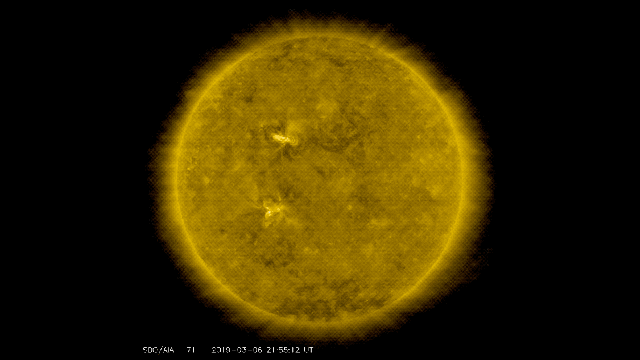Earlier this week, NASA’s Solar Dynamics Observatory (SDO) captured a strange series of images in which the Moon appears to go rogue, crossing the Sun as usual but then briefly pausing to change direction. No, it isn’t a sign of cosmological armageddon, but an optical illusion familiar to astronomers.
The SDO is currently in orbit around Earth, and it isn’t unusual for the NASA satellite to capture a lunar transit. The one observed on 6 March 2019, however, was unusual in that the Moon appeared to move from left to right across the surface of the Sun (normal), but then it paused for a moment and reversed direction (definitely not normal).
This is most certainly not the kind of behaviour you’d expect to see from the Moon — an object locked in an immutable, unidirectional orbit around Earth.
But there’s a perfectly rational explanation for this event: Retrograde motion. This optical illusion happens when “a celestial object appears to move backwards because of the way that different objects move at different speeds at different points in their orbits,” according to NASA.
Writing in EarthSky last year, astronomer Christopher Crockett described retrograde motion this way:
You can test it for yourself, the next time you pass a car on the highway. As you approach a slower car, it’s clearly moving in the same direction you are. As you pull alongside and pass it, however, from your vantage point the car appears to move backwards for just a moment. Then, as you pull ahead of it, the car appears to resume its forward motion.
The same thing happens as Earth passes the slower-moving outer planets. When we pass Jupiter or Mars or Saturn, for example, these more outward planets in orbit—which move more slowly than Earth in orbit—appear to reverse course in our sky for a couple of months.
In this case, the event lasted for a few minutes, rather than a couple of months, on account of the SDO’s close proximity to the Moon. So rather than the Moon changing direction, it’s the changing vantage point of SDO as it orbits Earth that caused the visual effect. An animated GIF provided by NASA illustrates this beautifully.
The frames used to produce the video of the lunar transit were captured as the satellite entered into the Moon’s shadow — conveyed by the vertical black line — with the Sun as backdrop. At the time, the SDO was moving at about 3km/s, in contrast to the Moon’s 2km/s, allowing the satellite to catch up with the Moon’s shadow.
As an interesting aside, retrograde motion messed up early astronomers who believed the Earth was at the centre of the universe. To explain the erratic behaviour of planets falsely believed to be in orbit around Earth, these astronomers devised all sorts of explanations, including the idea that planets rotated around a moving point in their orbit, in addition to rotating around Earth.
It wasn’t until the adoption of heliocentrism — the realisation that the planets rotated around the Sun — that the apparent back-and-forth movement of the outer planets was finally understood.
[NASA]
